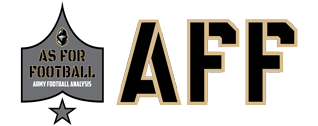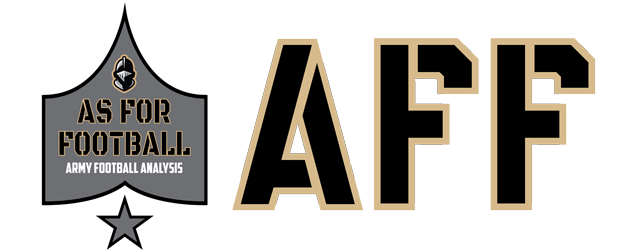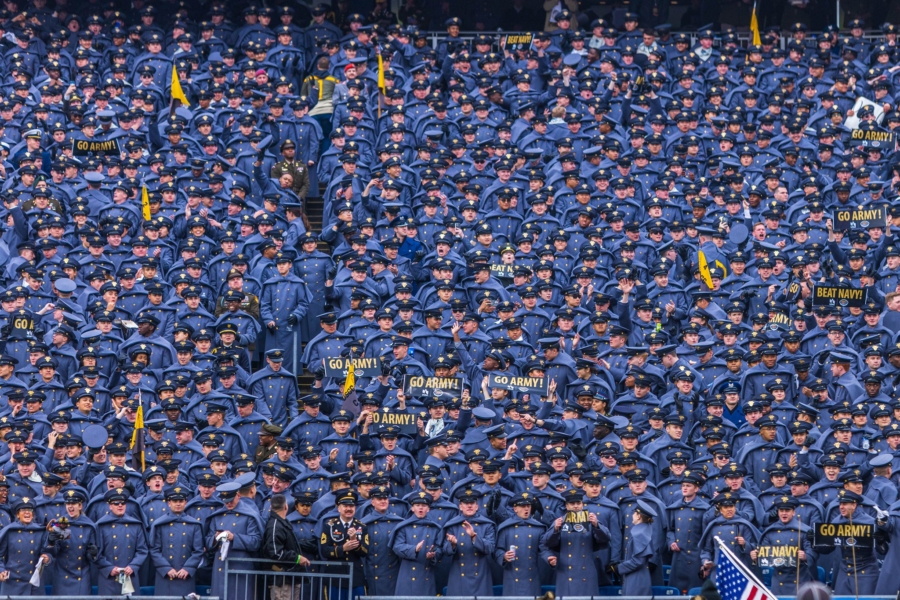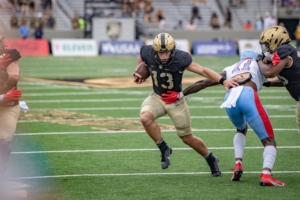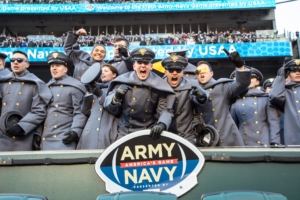As of last week, Army had five championship trophies left to earn in their final three games of the season — the American Conference Championship Trophy, the Secretary’s Trophy, the Commander-in-Chief’s Trophy, the Independence Bowl Trophy, and the Lambert Trophy. With their win over Tulane, the Black Knights secured the first of these highly coveted trophies. A win this weekend will secure two more, both the Secretary’s Trophy and Commander-in-Chief’s Trophy.

That is a lot of hardware!
In rivalry games, and particularly with big-time rivalry trophies on the line, you’ll often hear players and coaches tell you to throw out the statistics. You won’t get that treatment here! This week, instead of taking you through a normal preview phase by phase and match-up by match-up, we’re going to take you through some key statistics and other notes that we think are worth looking for while you watch this Saturday’s game.
Scoring
How do these two teams score?
Last year, we invented a few new statistics. One of those broke touchdown drives into three categories.
— Those beginning with a turnover or on downs
— Those that gained 10 yards per play or greater
— Those that gained fewer than 10 yards per play.
We called these Turnover Touchdown Drives (TTDs), Explosive Touchdown Drives (ETDs), and Blunt-Force Touchdown Drives (BTDs). The point was to show how reliant the 2023 Navy offense was on scoring on explosive plays.
Long story short, the Mids were VERY reliant on explosive plays last year.
Typically, option offenses score about half of their touchdowns via the BTD with about a 25%-25% split between the other two. This year, though, Navy’s touchdowns split almost perfectly into thirds. Army, by comparison, is much closer to the traditional splits. The Black Knights run a little higher on TTDs and a little lower on BTDs than usual this year because of the high volume of turnovers they’ve created.
How much do these teams score?
When triple-option teams play, the number of drives per game becomes extremely variable. When two triple-options teams play each other, that’s doubly true. Instead of looking at points per game, we therefore find it more telling to look at points per drive. Admittedly, this assumes that both teams get an equal number of drives.
The Miami Hurricane is currently the only team in college football averaging more points per drive than the Army Black Knights. Army scores an average of 3.68 points per drive. On average, they score a touchdown every other time they get the ball. Navy’s not far behind with 2.92 points per drive. Realistically, these numbers look close enough that neither of these offenses should be able to drastically outperform the other.
Editor’s Note: While I applaud James’s decision to up the ante here emotionally, Army scores just over 3/4 of a point more per drive. That is, in fact, a significant numerical advantage. Oddly, it looks like the difference comes mostly via made field goals. Army has kicked 8 where the Mids have made just 4.
Redzone Scoring and 4th Down Attempts
Another new statistic created last year was Redzone Points Percentage or RZP%. Instead of redzone percentage calculated as scores per opportunity, we calculated actual points as a function of total points possible. Last year, Army’s offensive RZP% advantage was about equal to the spread – 3.5 points. This year, Army again has the advantage. And the advantage is worth about 6.5 points – the same as the spread once again!
For those who want the actual numbers, Army scores about 87% of total possible points once they enter the redzone, while Navy scores about 85% of theirs. The big difference comes on defense where Army allows just 53% of possible points in defensive redzone situations while Navy gives up fully 65%.
Why does this matter?
The huge driving factor for Army’s defensive redzone stats comes from forcing 4th down attempts. This happens because Army has played most of the year with a lead and has limited opponent possessions effectively all season long. Below we see a chart of 4th down attempts per game in the Monken Era for both Army and their opponents.
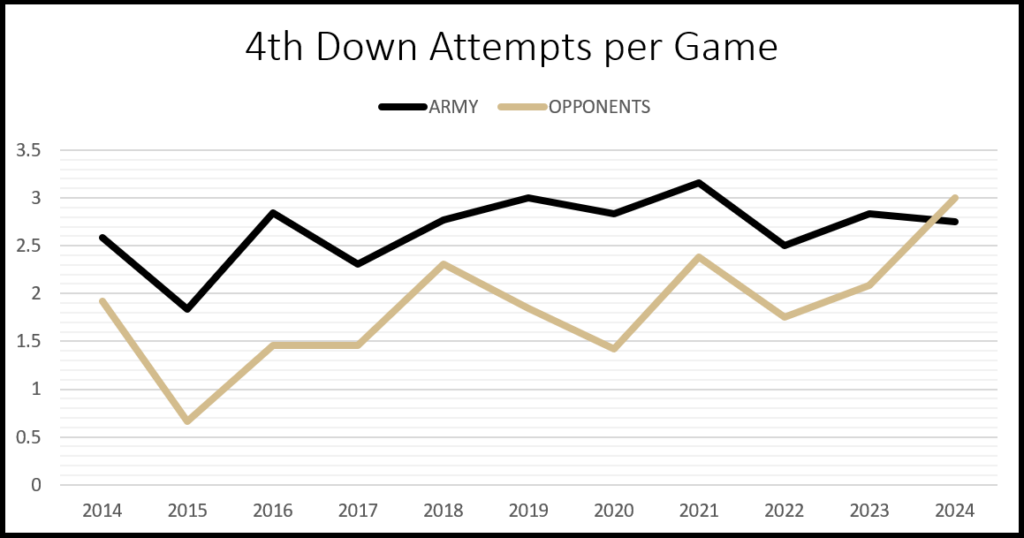
2024 might be the first year in which Army goes for it less than their opponents did. And that’s not because Army hasn’t gone for it much. It’s because they’re forcing their opponents to go for it fully 3 times per game! Moreover, the Black Knights get the stop a whopping 56% of the time.
If there’s a takeaway here, it’s that scoring first and playing with the lead matters in this game – more so than in your typical Army-Navy clash.
Schematic Differences
Many people see this year as a return to the traditional flexbone for Army. In many ways, that’s true. But we’ve seen a few key differences, too. None has been bigger than the offensive line. Army will be trotting out a starting offensive line that averages 307 pounds this Saturday.
Navy, on the other hand, has expanded from the traditional flexbone offense. In addition to that and some gun option packages, fans will see Navy run plays out of the Wing-T. Sometimes they’ll run what looks like a traditional option play out of a Wing-T formation. Sometimes they’ll run a Wing-T-looking Halfback Dive from the flexbone. It’s all about increasing the possibilities that defenses must prepare for on every play. But they’re doing it with a traditional service academy offensive line, averaging 288 pounds.
Additionally, Navy has increased the amount of passing it uses and has continued to blur the lines between A-Backs, B-Backs, and Slot Receivers. Again, this increases the number of play concepts a defense must prepare for from each formation. Moreover, the top trio of Midshipmen running backs – Alex Tecza, Eli Heidenreich, and Brandon Chatman – also lead the team in receiving.
Earlier in the year, when Navy was clearly improved on offense, a question arose. Is this new scheme working because it’s sound or because it’s new?
As with most things, the answer proved to be a little bit of both.
Navy’s quarterback really has to know the system. When starting QB Blake Horvath went down against Tulane, backup QB Braxton Woodson did not look comfortable — at all. The discrepancy became clear enough that Navy tried to go back to an injured Horvath over a healthy Woodson in the second half. But then Horvath stayed out against ECU, so Woodson got another chance. In the first half Navy couldn’t buy a point. By the second half, though, the new quarterback had finally figured it out, scoring five touchdowns on six drives.
Navy lists Horvath as available on their depth chart for the Army game, though they list both he and Woodson as possible starters. We’ll see who trots out there.
With all of that said, if there’s one place that Army can exploit this pair of quarterbacks, it comes because both guys have thrown a decent number of interceptions. Horvath has thrown 11 touchdowns against 4 interceptions and 8 sacks. Woodson has 2 touchdowns, 2 picks, and 1 sack.
Army’s secondary creates about 1.5 interceptions per game.
Learning from Previous Games
Going into the season, we expected three games might tell us something about how the Army-Navy Game would go. Unfortunately, we learned almost nothing from any of these.
Air Force-Navy
In CiC games, teams usually try to use new looks to confuse the opposing defense. Navy’s new offensive staff didn’t do that this time. You’d think we could learn from that, but Navy just didn’t use any new looks. Maybe they installed some new packages and/or formations, but they never used any of it because they maintained a comfortable lead throughout the contest.
Strike one.
Navy-Notre Dame
This was going to be the test of how Navy’s new scheme did against a big-time defensive line. So how’d they do? No idea. Navy gave up five unforced turnovers that had absolutely nothing to do with their scheme.
Strike two.
Army-Air Force
Would Army need to alter its scheme and give new looks to beat Air Force? Whether they needed to or not, they did. Army ran almost the entire game out of the gun. But that game didn’t involve Army starting QB Bryson Daily. So did they run that offense because of opponent or their personnel that day?
Strike three.
Big Questions
Will Army’s defense be able to read Navy’s new scheme? More game film helps, but this will be the first time the Black Knights see it live, and they didn’t get a bye week to get extra prepared.
Will either team need to trot out new packages to get their offense going? If so, what will that look like?
Who starts at quarterback for Navy? If it’s Horvath, how healthy is he? If it’s Woodson, how comfortable?
Special Teams
Place kicking probably leans in Army’s favor, as PK Trey Gronotte has been automatic inside of 40 yards, including Points After Tries (PATs). But his lone attempt from 40+ was no good. Navy PK Nathan Kirkwood has shown that he can hit from longer (46), but he’s missed a 21-yarder as well as 4 PATs.
Punting looks similar. Navy P Riley Riethman averages about 4 yards more per punt than Army’s James Wagenseller. But Wagenseller has put 40% of his punts inside the 20 without a single touchback. Riethman boots nearly a third of his punts for 50 yards, but also puts 10% into the endzone.
Final Thoughts
At the end of the day, everything could go according to plan for one of these teams until a blocked punt recovered in the endzone turns the whole thing upside down. That’s why they play the game! We can’t control any of that. Hopefully, however, some of the notes we’ve presented here have provided you with enough context to better understand why things happen this Saturday. That’s the goal.
The CiC standings over the last 13 years?
— Air Force – 4
— Army – 4
— Navy – 4
— Shared – 1
This game will break up what’s been a particularly even series of late. This year will also be just the sixth time in which both Army and Navy can win the trophy outright headed into this game. Previously, it happened in 1972, 1977, 1978, 1996, and 2017.
The weather shouldn’t play a factor. Landover will have temperatures in the mid-40’s with dry conditions on gameday. We’ll see a slight chance of rain in the second half, but hopefully the clouds stay away.
The game opened as a pick’em, but the line has moved sharply towards Army in the past few days. It currently sits at Army (-6.5). The total has come down steadily as well. As of this writing, it sits at Over/Under 39. That projects a rounded score of Army 23, Navy 16.
Coverage starts at 3:00 pm on CBS with kickoff usually around 3:30 pm. You can listen to Rich DeMarco and Dean Darling on the Varsity Network if you prefer that to the TV announcers. All of the usual suspects will either be at the game or on X.
If you want to attend the best Army Gameday chat around, come join the Firstie Club!
